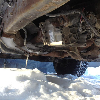danno2944
Active Member
- Joined
- February 22, 2018
- Messages
- 97
- Reaction score
- 4
- Year, Model & Trim Level
- 99 exp sprt 4x4 4.0sohc
My fuel pressure regulator is on the back of my drivers side fuel rail as far as I know.
Yours was on the pump? I
I had a p0442 I believe that's the right pid, for small evap emissions leak, I have replaced my old cap and haven't had a code since, but we will see. Filler neck is rough which is why I got new one. Question on the fuel pressure sensor, is it prone to a bad seal or breaking causing this code?
Yours was on the pump? I
I had a p0442 I believe that's the right pid, for small evap emissions leak, I have replaced my old cap and haven't had a code since, but we will see. Filler neck is rough which is why I got new one. Question on the fuel pressure sensor, is it prone to a bad seal or breaking causing this code?











